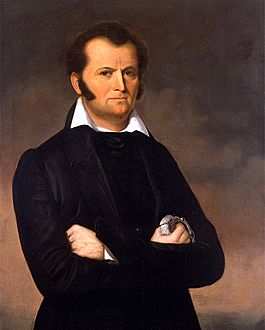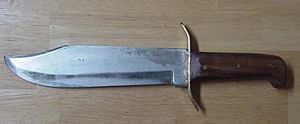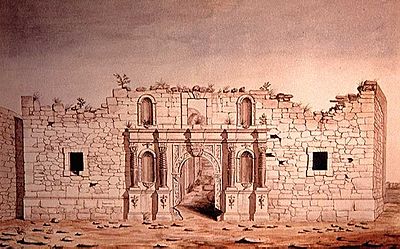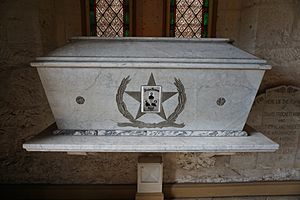Jim Bowie facts for kids
Quick facts for kids
James "Jim" Bowie
|
|
|---|---|

Bowie c. 1831–1834
|
|
| Nickname(s) | Jim Bowie Santiago Bowie |
| Born | April 10, 1796 Logan County, Kentucky, United States |
| Died | March 6, 1836 (aged 39) Alamo Mission, San Antonio, Texas |
| Allegiance | Republic of Texas |
| Years of service | 1835–1836 |
| Rank | Colonel |
| Unit | Texian volunteer army |
| Commands held | The Alamo San Antonio |
| Battles/wars | |
| Signature | |
James Bowie (pronounced BOO-ee) (April 10, 1796 – March 6, 1836) was a famous American pioneer and soldier in the 1800s. He played a very important part in the Texas Revolution. He was one of the brave Americans who died defending the Alamo.
Stories about Jim Bowie as a fighter and frontiersman, some true and some made up, have made him a legendary figure in Texas history. He is also known as a folk hero in American culture.
Bowie was born in Logan County, Kentucky. He spent most of his life in Louisiana. There, he grew up and later worked in buying and selling land. His amazing skill with a knife led to the widespread fame of the Bowie knife.
Bowie became even more famous during the Texas Revolution. After moving to Texas in 1830, he became a Mexican citizen. He married Ursula Veramendi, whose father was a high-ranking Mexican official. Bowie also led a trip to find a lost mine. During this trip, his small group fought off a large attack by Native Americans. This made him even more respected, even though they never found the mine.
When the Texas Revolution began, Bowie joined the Texas army. He led soldiers in battles like the Battle of Concepción and the Grass Fight. In January 1836, he arrived at the Alamo. He was in charge of the volunteer soldiers there until he became very ill. Jim Bowie died on March 6, 1836, along with the other Alamo defenders. Many stories exist about his death, but most say he died in his bed while fighting Mexican soldiers.
Contents
Jim Bowie's Early Life
James Bowie was born on April 10, 1796, in Logan County, Kentucky. He was one of ten children. His family moved several times, living in Georgia, Kentucky, Missouri, and then Louisiana.
Growing up on the frontier, the Bowie children learned to work hard. They helped clear land and grow crops. James and his older brother, Rezin, learned to read and write both English and Spanish. They also learned important survival skills like fishing and farming. James Bowie became very skilled with pistols, rifles, and knives. He was known for being fearless. As a boy, a Native American friend even taught him how to rope alligators!
In 1814, James and Rezin joined the Louisiana militia. They wanted to fight the British in the War of 1812. However, they arrived in New Orleans too late for the main battle. After leaving the militia, Bowie worked by cutting lumber and selling it. In 1819, he joined the Long Expedition. This group tried to free Texas from Spanish rule. Bowie returned to Louisiana before the Spanish army stopped the expedition.
Business Ventures and Land Deals
Around 1820, James and Rezin Bowie received some property from their father. For the next seven years, the brothers worked together. They developed large farms in Lafourche Parish and Opelousas. Louisiana's population was growing fast. The brothers wanted to make money by buying and selling land.
In 1818, they teamed up with a pirate named Jean Lafitte. At this time, the United States had a law against bringing new enslaved people from Africa. Some Southern states offered rewards to people who reported illegal slave traders. Informers could get half the money from the auction of the imported enslaved people.
Bowie used a clever plan. He bought enslaved people from Lafitte. Then, he took them to a customs office and reported his own actions. When the enslaved people were auctioned, Bowie bought them back. He then received half the price he paid as a reward, as allowed by state laws. This allowed him to legally transport and resell them for more money in New Orleans. Using this method, the brothers earned a lot of money for their land deals.
In 1825, the brothers bought a sugar cane plantation. They built the first steam mill for grinding sugar cane in Louisiana. This plantation became very successful. In 1831, they sold it and the enslaved people for a large sum of money. With their profits, James and Rezin bought another plantation in Arkansas.
The Famous Bowie Knife
Jim Bowie became famous around the world because of a fight. He had a disagreement with Norris Wright, the sheriff of Rapides Parish. Wright had refused a loan application from Bowie. After a fight in Alexandria, Wright shot at Bowie. After this, Bowie decided to always carry his hunting knife. This knife had a blade about 9.25 inches (23.5 cm) long and 1.5 inches (3.8 cm) wide.
On September 19, 1827, Bowie and Wright were at a duel in Natchez, Mississippi. The two duelists shook hands after firing shots and not getting hurt. But then, other people in their groups started fighting. Bowie was shot in the hip. He then pulled out his knife, which was described as a butcher knife, and charged Wright. Wright died instantly. This fight became known as the Sandbar Fight.
Newspapers wrote many stories about the Sandbar Fight. They described Bowie's amazing fighting skills and his unusual knife. Everyone agreed that Bowie did not attack first. Other fighters focused on him because they saw him as "the most dangerous man." This fight made Bowie famous as a superb knife fighter across the South.
Historians disagree about who designed the first Bowie knife. Some say Bowie designed it himself. Others say famous knife makers of the time did. His brother Rezin claimed to have designed it. Many of Bowie's family members and experts believe Rezin invented the knife. However, Rezin Bowie's grandchildren said that Rezin only watched his blacksmith, who was the real designer.
After the Sandbar Fight, the Bowie knife became very popular. Many people started making their own versions. Cities in the Old Southwest even had "Bowie knife schools." These schools taught people how to use the knife for fighting. Bowie's fame and his knife's fame spread to Great Britain. By the early 1830s, British companies were making Bowie knives to sell in the United States.
Today, a Bowie knife usually has a blade about 8.25 inches (21.0 cm) long and 1.25 inches (3.2 cm) wide. It has a curved point and a sharp "false edge" on the back. It also has a guard to protect the user's hands.
Life in Texas
In 1828, after recovering from his wounds, Bowie moved to Coahuila y Texas. This was a state in Mexico at the time. The Mexican laws said that only Roman Catholicism was allowed. They also preferred Mexican citizens for land grants. Bowie became a Roman Catholic in San Antonio on April 28, 1828. His sponsors were important local officials.
On January 1, 1830, Bowie moved to Texas for good. He swore loyalty to Mexico on February 20. He then went to San Antonio de Bexar. This city was mostly Mexican, and Bowie's ability to speak Spanish helped him settle in.
Bowie was chosen to lead a group of Texas Rangers that year. The Rangers were not officially organized until 1835. But they were a group of men hired to keep peace and protect settlers from Native American attacks. Bowie commanded a group of these volunteers.
Bowie gave up his American citizenship and became a Mexican citizen on September 30, 1830. He promised to build textile mills in the state. He partnered with his future father-in-law, Veramendi, for this. As a citizen, Bowie could buy large amounts of public land. He convinced other citizens to apply for land and then transfer it to him. This gave him a huge amount of land for speculation.
On April 25, 1831, Bowie married nineteen-year-old Maria Ursula de Veramendi. Her father was now the vice governor of the province. Bowie promised to pay his new wife a large sum of money or property within two years. At the time, Bowie claimed to be very wealthy, mostly in land. He also lied about his age, saying he was 30 instead of 35.
The couple built a house in San Antonio. But soon, they moved into the Veramendi Palace to live with Ursula's parents. They had two children, Marie Elve and James Veramendi Bowie.
Sadly, Maria Ursula, her parents, and both children died in September 1833. A terrible cholera sickness swept through the area. Bowie was away on business and did not hear about his family's deaths until November.
Searching for Lost Mines
After his marriage, Bowie became very interested in the story of the "lost" Los Almagres Mine. This mine was said to be northwest of San Antonio, near an old Spanish mission. Legend said that Native Americans had worked the mine before the Spanish took it over. After Mexico became independent, there were no government troops to protect miners from hostile Native American groups.
Bowie got permission from the Mexican government to search for the mine. On November 2, 1831, he, his brother Rezin, and ten others set out. Six miles from their goal, they met a large group of Native Americans. Attempts to talk failed, and Bowie's group fought for 13 hours. Bowie's group lost only one man, while many Native Americans were killed or wounded.
News of the large Native American group reached San Antonio. People there thought Bowie's group must have died. Ursula Bowie even started wearing clothes for mourning. But to everyone's surprise, the surviving members of the group returned to San Antonio on December 6. Bowie's report of the trip was printed in newspapers, making him even more famous. He went out again with a larger group, but still did not find the mine.
Despite his growing fame, Bowie never talked much about his adventures. People who spent time with him described him as a humble man.
Fighting for Texas
Growing Tensions
Between 1830 and 1832, the Mexican government passed laws that seemed unfair to American settlers in Texas. This caused more tension between the settlers and Mexican officials. Mexican troops set up military posts in Texas. Many of these troops supported President Anastasio Bustamante. However, Antonio López de Santa Anna led a rebellion against Bustamante in 1832. American settlers in Texas supported Santa Anna.
In July 1832, Bowie heard that the Mexican army commander in Nacogdoches wanted all residents to give up their weapons. Bowie quickly returned to Texas. On August 2, 1832, he joined other Texans and marched to Nacogdoches. They wanted to "present their demands" to the commander. Before they reached the town office, Mexican cavalry attacked them. This started the Battle of Nacogdoches. The Texans fought back. After a second battle, the Mexican army left during the night. Bowie and 18 friends ambushed the fleeing army. They marched the soldiers back to Nacogdoches. Bowie later helped represent Texas at a meeting in 1833. At this meeting, Texans formally asked to become their own state within Mexico.

A few months later, a cholera sickness hit Texas. Bowie sent his pregnant wife and daughter to her family's home in Monclova. Her parents and brother went with them. The cholera epidemic struck Monclova, and between September 6 and September 14, Ursula, their children, her brother, and her parents all died. Bowie was away on business and did not learn of his family's deaths until November.
The next year, the Mexican government allowed land sales in Texas again. Bowie went back to dealing in land. He was appointed a land commissioner. His job was to help people settle in an area bought by John T. Mason. His appointment ended in May 1835. This happened when President Antonio López de Santa Anna ended the Coahuila y Tejas government. He also ordered the arrest of all Texans doing business in Monclova, including Bowie. Bowie had to escape Monclova and return to the American areas of Texas.
The American settlers in Texas began to push for war against Santa Anna. Bowie worked with William B. Travis, a leader of the War Party, to get support. Bowie visited several Native American villages. He tried to convince them to fight against the Mexican government. Santa Anna responded by sending many Mexican troops to Texas.
Battle of Concepción
The Texas Revolution officially began on October 2, 1835, with the Battle of Gonzales. Stephen F. Austin formed an army of 500 men. They marched towards the Mexican forces in San Antonio. On October 22, Austin asked James W. Fannin and Bowie to scout the area around two missions. Bowie was now a colonel in the volunteer army. They needed to find supplies for the soldiers. The scouting party had 92 men, including many from the New Orleans Grays. They found a good defensive spot near Mission Concepción. They asked Austin's army to join them there.
On the foggy morning of October 28, Mexican General Domingo Ugartechea led 300 soldiers and two small cannons against the Texans. The Mexican army got within 200 yards. But the Texan position protected them from fire. When the Mexicans stopped to reload their cannon, the Texans climbed a hill. They shot at some of the soldiers. The fight ended when Bowie led a charge to capture one of the Mexican cannons. It was only 80 yards away. Ugartechea retreated with his troops. This ended the Battle of Concepción. One Texan and ten Mexican soldiers were killed. One of Bowie's men later praised him as a great leader. He said Bowie never wasted a bullet or risked a life. He always told them, "Keep under cover boys, and reserve your fire; we haven't a man to spare."
The Grass Fight
An hour after the battle, Austin arrived with the rest of the Texan army. They began to surround San Antonio de Béxar. General Martín Perfecto de Cós, the Mexican commander, and his troops were inside the city. Two days later, Bowie left Austin's army. He did not have an official rank in the army. He also did not like "minor tasks of scouting and spying."
On November 3, 1835, Texas declared itself an independent state. A temporary government was formed. Henry Smith was chosen as the temporary governor. Austin asked to leave his command of the army. Sam Houston was named the army chief. Edward Burleson became the temporary commander of the troops in San Antonio. Bowie asked the council for a military rank. But they refused, probably because of past issues with his land deals.
Houston offered Bowie a job as an officer on his staff. But Bowie said no. He wanted to be in the middle of the fighting. Instead, Bowie joined the army as a regular soldier under Fannin. He showed his bravery again in the Grass Fight on November 26. General Cós had sent about 187 men to cut grass for his horses. As they returned to San Antonio, Bowie took 60 mounted men to stop them. The Texans thought the Mexican party carried valuable goods. The Mexican troops sped up to reach the city's safety. But Bowie and his cavalry chased them. At the end of the fight, the Texans had two wounded men. But they captured many horses and mules.
Soon after Bowie left San Antonio, Ben Milam led an attack on the city. The Texans had few casualties. Milam was among them, but he died. The Mexican army lost many soldiers to death and desertion. Cós surrendered and returned to Mexico. He took the last Mexican troops in Texas with him. Many Texan volunteers believed the war was over. They left the army and went home. In early January 1836, Bowie went to San Felipe. He asked the council to let him gather a new group of soldiers. He was turned down again. They said he "was not an officer of the government nor army."
The Battle of the Alamo
Houston heard that Santa Anna was leading a large army to San Antonio. Bowie offered to lead volunteers to defend the Alamo. He arrived with 30 men on January 19. They found 104 men there with few weapons, cannons, or gunpowder. Houston knew there were not enough men to hold the fort. He told Bowie to remove the cannons and blow up the fort. But Bowie and the Alamo commander, James C. Neill, decided they did not have enough oxen to move the cannons. They also did not want to destroy the fort. On January 26, one of Bowie's men, James Bonham, organized a meeting. They decided to hold the Alamo. Bonham signed first, and Bowie signed second.
Bowie spoke Spanish well and had many Mexican friends and family. Because of this, the Mexican people in San Antonio often gave him information about the Mexican army. Bowie learned that Santa Anna had 4,500 troops and was coming to the city. He wrote several letters to the government asking for help. He needed "men, money, rifles, and cannon powder." In a letter to Governor Smith, he said, "the salvation of Texas depends in great measure on keeping Béxar out of the hands of the enemy." He added, "Colonel Neill and myself have come to the solemn resolution that we will rather die in these ditches than give it up to the enemy."
On February 3, Davy Crockett arrived with thirty men from Tennessee. Neill left on February 11 to visit his sick family. This left Travis, a regular army officer, in command. Bowie was older than Travis. He also had a better reputation and saw himself as a colonel, which was a higher rank than Travis's. Bowie refused to take orders from Travis. Travis then held an election for the men to choose their commander. They chose Bowie, which made Travis angry. But two days later, they agreed to share command. Bowie would lead the volunteers, and Travis would lead the regular army and cavalry.
On February 23, the bells of San Fernando rang. This was a warning that the Mexicans were coming. Travis ordered all Texan forces into the Alamo. Bowie quickly gathered supplies and brought cattle into the Alamo.
Bowie worried about his wife's relatives in San Antonio. He invited her cousins, Getrudis Navarro and Juana Navarro Alsbury, and Alsbury's young son, to stay inside the Alamo. Bowie also brought several black servants into the fort for safety. Bowie had become very ill. Two doctors could not figure out what was wrong with him. Travis became the only commander when Bowie was confined to his bed. Santa Anna and his army began to surround the Alamo on February 24. The Mexican army raised a red flag. This meant they would not show mercy to the defenders.
Bowie and Travis sent out messengers. They asked for supplies and help. On February 25, Travis sent Juan Seguin on Bowie's horse to get more soldiers. Thirty-two more men arrived. On February 26, Crockett reported that Bowie, though sick, still crawled from his bed each day. He showed himself to the Alamo's defenders. This greatly boosted their spirits.
Thirty-five years after the Alamo fell, a reporter said that Louis "Moses" Rose was the only man to have left the Texan forces at the Alamo. According to Rose's story, Travis drew a line in the sand. He asked those willing to die to cross the line. At Bowie's request, Crockett and others carried his cot over the line. Rose was left alone on the other side. After this story came out, other witnesses confirmed it. But since Rose was dead, the story relies on the reporter's word. The reporter admitted to making up parts of other articles. So, many historians do not believe this story.
Bowie died with the other Alamo defenders when the Mexicans attacked on March 6. Most of the people who were not fighting, including Bowie's relatives, survived. Santa Anna ordered the mayor of San Antonio, Francisco Antonio Ruiz, to identify Bowie, Travis, and Crockett. Santa Anna first ordered Bowie to be buried. He said Bowie was too brave to be burned like a dog. But later, Santa Anna had Bowie's body placed with the other Texans on the funeral pyre.
When Bowie's mother heard of his death, she calmly said, "I'll bet no wounds were found in his back." This meant she believed he died fighting bravely, facing the enemy.
One year after the battle, Juan Seguin returned to the Alamo. He gathered the remaining ashes from the funeral pyre. He put them in a coffin with the names of Bowie, Travis, and Crockett. The ashes were buried at the Cathedral of San Fernando.
Jim Bowie's Legacy
Even though Bowie claimed to be rich, his property was found to be very small after his death. His belongings were sold for only $99.50. His bigger legacy is his place as "one of the legendary characters of the American frontier." Bowie left very few written records of his life. So, for many, "where history failed, the legends prevailed."
While Bowie and his knife were famous during his life, his legend grew after 1852. That year, his brother, John Jones Bowie, wrote an article called "Early Life in the Southwest—The Bowies." This article focused mainly on Jim Bowie's adventures. After this, many "romanticized stories" about Bowie started appearing in national newspapers. Often, these stories were like melodramas. Bowie would rescue a naive planter's son or a damsel in distress.
Jim Bowie was added to the Blade Magazine Cutlery Hall of Fame in 1988. This was to recognize how his knife design influenced many knife makers and companies.
Many movies have shown the Battle of the Alamo. Bowie has been a character in each of them.
From 1956 to 1958, Bowie was the subject of a CBS television series called The Adventures of Jim Bowie. The show was mostly set in Louisiana in the 1830s. Later episodes went into Mexican Texas. The show starred Scott Forbes as Jim Bowie. It was based on the 1946 novel Tempered Blade.
Rock star David Bowie, whose real name was David Robert Jones, took his stage name from Jim Bowie. Jones changed his last name in the 1960s. He did not want to be confused with Davy Jones from the famous band The Monkees. He chose "Bowie" because he admired James Bowie and the Bowie knife. However, he pronounced it differently (BOH-ee).
Bowie County in northeast Texas and the city of Bowie in Montague County, Texas, were both named after James Bowie. James Bowie Elementary in Corsicana, Texas was also named in his honor.
Movies and TV Shows About Jim Bowie
There have been several movies about the Battle of the Alamo. Bowie has appeared as a character in many of them:
- The Iron Mistress (1952) starred Alan Ladd as Jim Bowie.
- The Last Command (1955) featured Sterling Hayden as Jim Bowie.
- The Alamo (1960) starred John Wayne as Davy Crockett and Richard Widmark as Jim Bowie.
- The Alamo (2004) starred Jason Patric as Bowie.
On TV:
- From 1956 to 1958, the CBS television series The Adventures of Jim Bowie was about him. It starred Scott Forbes.
- In 1995, Kenneth Tobey played Bowie in a Walt Disney miniseries called Davy Crockett at the Alamo.
Images for kids
See also
 In Spanish: James Bowie para niños
In Spanish: James Bowie para niños







